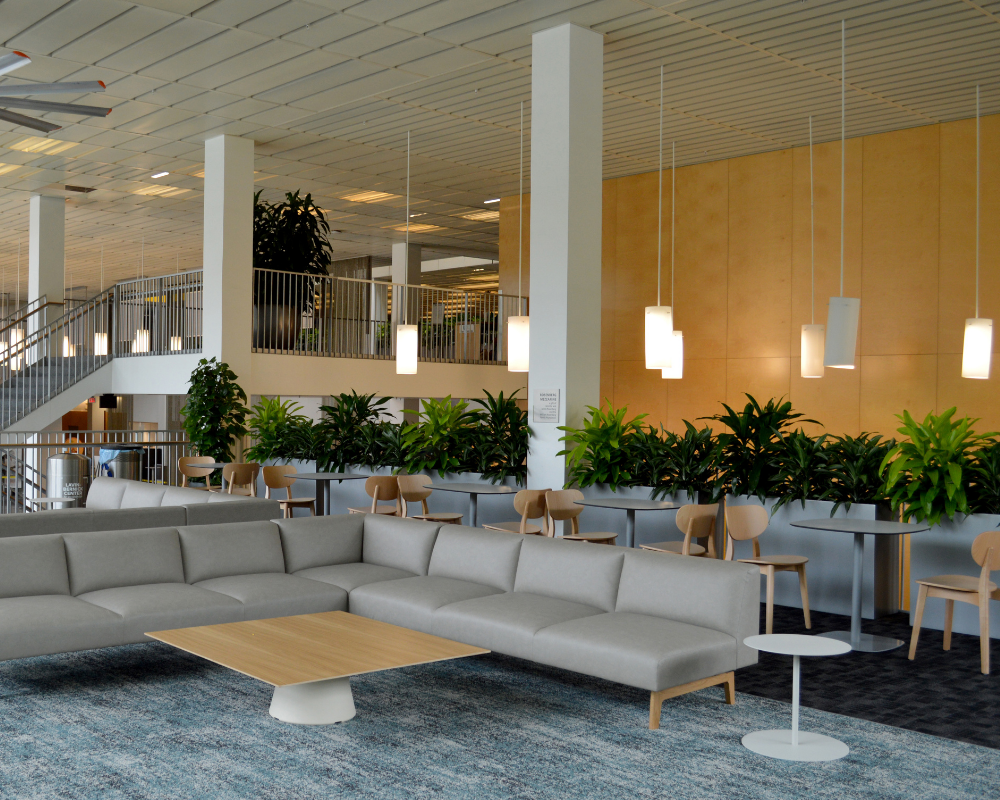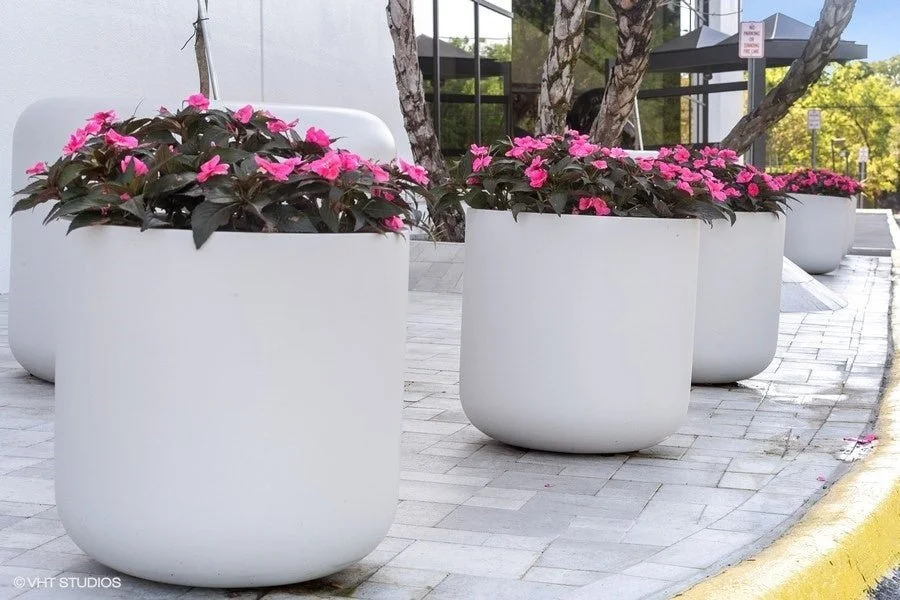All You Need to Know About Fiberglass Planters
There’s a lot to consider when creating an incredible commercial, residential, or hospitality design project. You need to design a functional layout, strategically select raw materials, and make granular decisions about details like fire features, furniture, and decor.
And when you’re mapping out your project, planters should be high on this list of vital details. Planters elevate design and tie any space together by adding a burst of life and vibrance.
While there are plenty of planter materials to choose from, fiberglass is one of the most common on the market for a long list of reasons.
Here’s what you need to know.
What Is a Fiberglass Planter?
Fiberglass is a composite material made of molten glass that’s been forced through small holes and then woven into fibers.
The material itself is used for everything from ceiling insulation to piping and personal protective equipment. At PureModern, we offer an array of fiberglass planters in several finishes, including faux metal, stone, and wood.
To create our fiberglass planters, we follow a specific five-step process:
Create a mold (also known as a plug) from wood or plastic in the desired shape and size of the planter
Hand-lay fiberglass and resin onto the mold
Allow the planter to dry
Remove the planter from the mold, then continually sand it until all imperfections are gone
Finish the planter with primer and the color of your choice
For large planters, we internally reinforce the integral structure during the manufacturing process.
5 Benefits of Fiberglass Planters
From powder-coated aluminum to COR-TEN weathering steel and fiberglass, every type of planter material has its pros and cons, and not all planters are suitable for every application.
To pick the right planters for your project, seek to understand the strengths and weaknesses of each option. From there, you’ll begin to see which type of planters are best for your particular situation. With that being said, fiberglass planters offer a long list of pros.
PurePots Fiberglass Planters at Tulane University in New Orleans, LA
Fiberglass Planter Benefit #1: Solid Value
At PureModern, we believe buying a commercial-grade planter at a higher price point is much more cost-effective than spending less initially for a lower-quality planter and having to replace it every few years.
Fiberglass planters:
Have significant staying power in your space
Don’t warp or become misshapen when exposed to the elements
Are resistant to UV rays
Handle wear-and-tear well in high-traffic areas where your planters are liable to get bumped into, knocked over, nicked, and scratched
Fiberglass Planter Benefit #2: Stylish Look and Feel
The manufacturing process of fiberglass planters allows a variety of shapes to be created and they can be finished in a rich array of colors. Fiberglass planters are dynamic by nature and incredibly stylish.
For example:
Fiberglass planters with subtle designs and muted colors can be an elegant and understated addition to your project.
Uniquely shaped planters boasting a bright and vibrant color can be a perfect statement piece in your space.
The opportunities are endless.
Fiberglass Planter Benefit #3: Light Weight
When you purchase a planter made of concrete or steel, the initial placement of the planter becomes especially important. Unless you’ve got some heavy machinery at your disposal, the weight of these products — even without soil — means the planter will likely live in that spot forever.
While permanent placement is fine in some situations, it limits your ability to relocate the planter if you see an opportunity to create new spaces, separate existing spaces, or flank walkways.
Should you need to relocate your planters, fiberglass is your best choice because it’s incredibly lightweight, making it easier to move than its COR-TEN weathering steel or concrete counterparts.
Fiberglass Planter Benefit #4: Weather and UV Resistance
Not all materials are made equal, and that’s especially true when it comes to how they handle the elements.
For instance:
Concrete is liable to crack and chip after a few bouts with harsh weather.
Some lower-grade metals can expand, contract, and warp with temperature variations and rust when exposed to excessive moisture.
Some non-commercial paints and finishes can fade with prolonged exposure to sunlight.
But fiberglass planters are an exception.
When finished with commercial-grade automotive paint, which features specialized resins, pigments, and additives for enhanced performance, fiberglass planters are resistant to frost, corrosion, and UV rays.
Fiberglass Planter Benefit #5: Low Maintenance
Given their ultra-durable nature, fiberglass planters require a very minimal amount of maintenance. They can generally be left for extended periods of time with little to no upkeep.
To keep them looking their best, simply clean the planter with dish soap and warm water using a nonabrasive cloth and then apply the same wax you’d use on your car.
The Downside of Fiberglass Planters
For all of the benefits offered by fiberglass planters, no product is ever perfect.
To make the right decision for your project, it’s worth understanding the most common sticking points that designers encounter when purchasing fiberglass planters.
Price Point
One drawback of fiberglass planters is price, especially compared to their plastic counterparts.
But remember: you’re better off buying a commercial-grade product than trying to cut costs. By trying to save now, you’re likely to spend much more money in the long run, not to mention the time you’ll spend repeatedly arranging for repairs and replacements.
While fiberglass planters may cause a bit of sticker shock, the fact of the matter is that you get what you pay for.
Lead Time for a Custom Shape
Sometimes you might be unable to find a specific shape that fits your design.
In this case, customizing a fiberglass planter is an option, but you should be aware that such customization can cause longer lead times than you might expect. Depending on the custom shape and size, you could be looking at 3 months — and that’s just for manufacturing.
Also consider that customization of shape with fiberglass has a minimum order requirement, which is usually reserved for large-scale projects.
If you’re only customizing for color, the lead time may not be quite as long. In fact, assuming the selected color is in stock, manufacturing lead times can be as short as a week.
Custom Fiberglass Planters at SCAN Design in Altamonte Springs, FL
Are Fiberglass Planters Better Than Others?
When it comes to picking planters for your project, it would be ill-advised for us to claim one material is better than another. The answer to this question is entirely dependent on the needs of your particular project.
To decide which planter material is best, let’s try comparing fiberglass planters against planters made from different materials, taking the needs of your particular project into account.
Fiberglass Planters vs. Plastic Planters
People love the price tag for plastic planters, but that’s essentially the only reason to choose plastic over fiberglass.
Fiberglass offers significantly higher durability meaning you won’t have to throw them away after they inevitably wear out. And rather than having to choose a pre-made plastic planter in a color that doesn’t quite fit, you can choose a color that matches your branding perfectly.
Choose fiberglass planters over plastic planters when:A custom color is specifiedA commercial-grade planter is a critical attribute
Fiberglass Planters vs. Wooden Planters
Wooden planters have an attractively rustic, natural aesthetic. And for many designers and projects, this is a perfect fit.
But when choosing between fiberglass and wooden planters, here are a few things to think about:
Fiberglass planters will have greater longevity than wood
Wooden planters can come with a higher price tag than fiberglass planters
Because wood is significantly heavier than fiberglass, wood planters can be even more difficult to relocate
While both are high-quality materials that make for great planters, we recommend choosing fiberglass when your planter will be frequently exposed to water or harsh weather conditions.
Choose fiberglass over wood planters when:There is a fixed budgetThe planter will be exposed to harsh weather conditionsRelocation of the planter is possible
Fiberglass Planters vs. Concrete Planters
Many people choose concrete planters because of concrete’s rustic and minimalist characteristics. When you’re trying to decide between concrete and fiberglass planters, there are a few items to consider.
Keep in mind that concrete planters:
Are extremely heavy and hard to move
They can crack and break, especially when moving them into place or after prolonged exposure to the elements
Offer more flexibility with regard to shape than fiberglass planters, but fewer color and style options
Ultimately, fiberglass planters will give you more styles and colors to choose from and will also look and perform better in the long term.
Choose fiberglass planters over concrete planters when:Relocation of the planters is possibleRequire a custom color
Fiberglass Planters vs. Metal Planters
Metal and fiberglass are two very common planter materials. But there are a few things to consider when deciding between the two:
Many types of metals can be used in the production of planters, including COR-TEN weathering steel, which has a raw appearance and develops a natural patina over time, and powder-coated aluminum, which can be finished in a wide array of colors.
Because there are so many types of metals and styles, the price tag for metal planters can vary significantly.
While fiberglass is lightweight, metal planters, including COR-TEN and galvanized steel, can be heavy and hard to move with the exception of powder-coated aluminum planters.
While fiberglass planters will stand up to temperature fluctuations and moisture, some steel metals will rust when left exposed to the elements. For example, fiberglass planters will not rust, but COR-TEN weathering steel doesn’t fare well in locations with salty air.
Fiberglass planters can be made into any shape, whereas metal can be made only in geometric shapes.
Choose fiberglass planters over metal planters when:A unique shape is required; one that is not geometricThere is a fixed budget, as metal planters are typically more expensiveYou need a planter shipped within 1 to 2 weeks — metal typically takes 4-6 weeks
Learn More
Selecting the right planters is a pivotal part of every design project. But with so many options to choose from, it’s easy to become overwhelmed when making a selection.
Ultimately, the best way to go about picking the right planters is understanding the pros and cons of each type of material. This way, you can envision exactly how well the planter will fit into your design plans.
But when you need a lifetime product that’s durable, lightweight, stylish, and you can’t go wrong with fiberglass planters.
Have questions about custom fiberglass planters? To find out which planter is best for your space, contact an expert at PureModern today.



